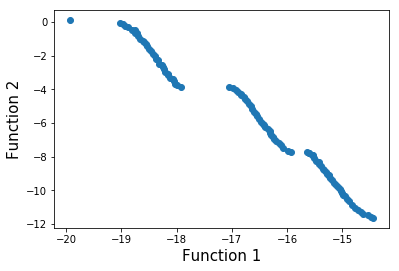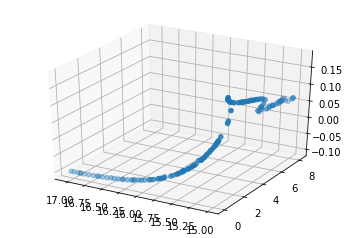Implementation of NSGA-II algorithm in form of a python library.
This implementation can be used to solve multivariate (more than one dimensions) multi-objective optimization problem. The number of objectives and dimensions are not limited. Some critical operators are chosen as: Binary Tournament Selection, Simulated Binary Crossover and Polynomial Mutation. Note that we didn't start everything from scratch but modified the source code from wreszelewski/nsga2. We are very thankful to Wojciech Reszelewski and Kamil Mielnik - authors of this original version. The following items are modified:
- Fix the crowding distance formula.
- Modify some parts of the code to apply to any number of objectives and dimensions.
- Modify the selection operator to Tournament Selection.
- Change the crossover operator to Simulated Binary Crossover.
- Change the mutation operator to Polynomial Mutation.
-
Class Problem
Defined in problem.py.
Using to define a multi-objective problem.
Arguments:
objectives: A list of functions, representing the objective functions.num_of_variables: An integer, representing the number of variables.variables_range: A list of tuples of two elements, representing the lower and upper bound of each respective variables.same_range: A boolean argument, default =False. If true, the range of all variables are the same (this casevariables_rangehas only one element), otherwise each variable has its own range.expand: A boolean argument, default =True. If true, input of functions are treated as list of respective variables (e.x.f(x,y,z)), otherwise they are treated as a vector (e.x.f([x1, x2, x3])).
-
Class Evolution
Defined in evolution.py.
Using to run NSGA-II.
- Arguments:
problem: An object of class Problem.num_of_generations: An integer, default = 1000, representing the number of generations.num_of_individuals: An integer, default = 100, representing the number of individuals, a.k.a the population size.num_of_tour_particips: An integer, default = 2, representing the number of participants in tournament selection operator.tournament_prob: A real number, default = 0.9, representing the probability used in tournament selection.crossover_param: An integer, default = 2, representing the parameter used in simulated binary crossover.mutation_param: An integer, default = 2, representing the paramenter used in polynomial mutation.
- Methods:
evolve:- Arguments: None.
- Return: List of the best individuals in the last generation.
- Arguments:
Examples about SCH problem and KUR problem are showed in sch.py and kur.py.
In addition, the results of some popular multi-objective problems is demonstrated as belows:
- Pham Ngo Gia Bao, Ho Chi Minh University of Technology
- Tram Loi Quan, Ho Chi Minh University of Technology
- A/Prof. Quan Thanh Tho, Ho Chi Minh University of Technology (advisor)
- A/Prof. Akhil Garg, Shantou University (advisor)
We are very thankful to A/Prof. Tho and A/Prof. Akhil for helping and guiding us to finish this work.




